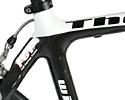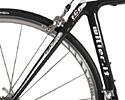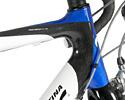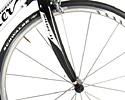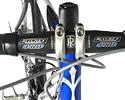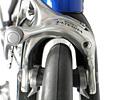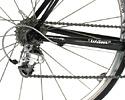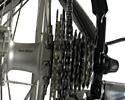
Recently on Cyclingnews.com |
On test: Wilier Thor Ultegra, January 31, 2006
Italian tradition meets carbon
The Wilier Thor brings a long, rich heritage to bike building, as Wilier Triestina was founded 100 years ago in 1906. How does this old world tradition blend with modern day frame materials like carbon fiber? Chris Davidson takes a look.

|
Wilier Triestina is not a new name to the cycling world. As one of the oldest Italian names in bicycle building, the company has an equally long commitment to racing. For the company's centennial year in 2006, two ProTour teams will compete on Wilier bikes: Lampre-Fondital and Cofidis. While Lampre will return to the fold for Wilier in 2006, Cofidis is in its third year with this famous Italian brand, and the Gerolsteiner squad of Davide Rebellin was aboard Wilier bikes for the 2004 season. The Thor bike comes in four sizes with sloping top tube geometry (see www.wilier.it for geometry specifications). The frame is designed and assembled of carbon tubes and lugs in a seamless manner that provides continuously radiused curves over the frame. The bottom bracket shell and rear dropouts are made of aluminium. The fork has carbon fiber legs with an aluminium steerer tube and fork tips. The bike has a white and blue paint scheme over clear coated carbon; the bike is also available in a similar paint scheme with red and silver replacing the blue and white. The Wilier website claims that the Thor weighs 8.7 kg, however the large sized test bike that I rode came in at 8.1kg; refreshing to find a bike that actually is lighter than the manufacturer claims.
The parts specification on this bike reflects excellent decisions for a mid-priced bike. My test bike came with a complete Shimano Ultegra group, Ritchey Pro oversized bar and stem, and a Selle Italia Filante saddle on top of a Selcof Premium carbon post. The Shimano R-550 wheels were shod with Schwable Stelvio 700x23c tires.
The Thor equipped as I tested it sells for $3,250 in the US, with the only difference in the parts spec sees Mavic Aksium wheels replace the Shimano R-550 wheels. The Thor is also available for $3350 with upgraded FSA bar, stem, post and carbon crankset. While Wilier makes many other frames/complete bikes up to the all carbon Le Roi which will carry Grand Tour contenders up the steepest climbs, the Thor represents their first opportunity for a buyer to get on a complete Wilier carbon bike. From this point of view the parts spec and the complete bike weight are right on.
Getting it right
I first got a good look at a current Wilier in checking out Tyler Farrar’s new Cofidis training bike as we spent our last night in Europe after Road Worlds at the USA U-23 house in Izegem. I was keen to get to ride one of the bikes from this manufacturer steeped in the European racing tradition.
I added a pair of Speedplay pedals and rotated the handlebars up a tad on the 12cm stem to get everything fitted up. The carbon down tube on the Thor flares out at the head tube and bottom bracket to provide extra stiffness, however the top tube is round, and flares only minimally at the head tube The resulting head tube is on the shorter side, rather than the longer. For me that meant rotating the bars up a little more than I normally would, Our test bike came with the steerer tube already cut down and 15mm of spacers under the stem, so I did not have the option of raising it.
After setting the saddle in the right position, I hopped aboard the Filante saddle and went for a short spin. I have never ridden this saddle before, however I found it quite comfortable and similar in shape to many of the other Selle Italia models. The Selcof post had a two bolt clamp that allowed for easy adjustment of setback and tilt, while providing plenty of clamping area. With easy setup and good fit dealt with, I was excited about putting in the miles.
Over the next three weeks I rode the bike in a number of different settings (in frigid temperatures here in Utah) to assess ride characteristics and feel. The overall word that best summarises my experience riding the Thor is ‘solid’. There are a number of things worth knowing about the ride of the Thor; they break down logically in to the following areas for me.
Usable rigidity (Stiffness when climbing, sprinting, powering the flats, etc.) I really liked the stiffness of this bike. It was not the stiffest bike I have ever ridden, but on a scale of 1-10 I would rate it an 8. With this, I think that bikes can be overly stiff and that can distract from the ride. In the case of the Thor I think that the bike really has an excellent balance of stiffness without harshness. While seated climbing the bike feels like it tracks on a rail and puts all of your grunt on the pedals to work in propelling you forward. Out of the saddle the bike, with its compact geometry, seems snappy and direct underneath you.
The most distinctive part of the ‘usable rigidity’ on this bike would have to be the front end. In a quest to deliver the lightest bike possible, a number of manufacturers have specified sub 300g forks. Sometimes this leaves the front end of the bike too light, biasing the weight balance heavily on the rear end of the bike. On the road this can manifest itself as a whippy front end that undermines confidence when driving the bike hard into corners. The Thor feels very confident and solid in the front end. It steers and tracks with a definitive feel that inspires confidence when cornering, accelerating out of the saddle, and descending. Maybe it is the rigidity of the aluminium steerer on the fork, maybe it is fork geometry and materials, or possibly the lack of silly light weight; regardless there are areas where light is not always right and the Thor really impressed me up front.
Responsiveness, handling, agility (Ability to chose a line, maintain it and do it effortlessly) While I may have bled over onto this section with the description above, there are some points worth noting separately here. To start, I found the wheelbase on the Thor very reasonable for a compact geometry bike. In an effort to make a bike feel ‘fast’ and ‘aggressive’, some manufacturers like shorter wheelbases and quicker handling bikes. The Thor seems a little more conservative in the area of wheelbase and consequent handling. Maybe this is a link to the European racing heritage, but combined with the stiffness and solid front end makes for a great handling package. This bike made me want to attack corners on the descents. When it was necessary to make adjustments to the riding line mid corner or swerve to avoid a road hazard, I did not feel like this would necessarily require a handful of brake to execute successfully. These are more factors that go into the assessment of this bike as 'solid'.
Overall, while the geometry might be conservative to some, I found the ride confident from the start. When hopping on a new bike for the first time, one might be reluctant to take a corner flat out immediately. However, I found this bike to be reassuring at every new handling concern during my initial rides. It may be hard to pinpoint the direct source of this overall feeling when riding the bike, but it is a characteristic that can easily outweigh a number of other factors when choosing a new ride. Makes a thorough test ride a must for any new bike that you might consider. The Thor delivered here.
Comfort (Ability to put in long miles without undue fatigue) Good things to report here. I took to the Selle Italia Filante saddle pretty quickly, and since a lot of the road feel/fatigue combination reaches your body through your butt, I was pretty pleased with how it went on longer rides. The bike did not feel overly harsh from a fatigue standpoint; rather the carbon frame and fork seemed to be up to task in filtering out the irregularities of the road. I personally like the bend and drop of the Ritchey bars and had no problem keeping my hands feeling fresh by varying my grip on the bars during rides. I realise that both of these items [saddle and bars] are highly individual choices and will not work for everyone. However, in the overall context of this complete bike I come away with a very positive impression of the way the bike feels based on these component choices. Bike comfort is so specific to fit and component choices that the contribution of the frame itself is sometimes lost. I think that Wilier has a good selection of parts which complement the frame qualities.
Maybe not specifically affecting ‘comfort’, nothing is more annoying than a bike that is does not work 100%. I am happy to say that the Ultegra parts on this bike performed really well. The drivetrain shifted well, the brakes provide excellent modulation and power and the crankset/BB impresses with its rigidity. I am disappointed that I did not get to test the new Mavic Aksium wheels that will come on the bike, however the Shimano R-550 ride solidly, although they are a little on the heavy side. The Schwalbe tires hooked up well with their slick tread, I could not see a difference in their design, although they are labeled in big white letters on the sidewall: ‘Front’ and ‘Rear’.
Mechanic's report
As a pro mechanic as well as a rider, I like to comment of some things that may be invisible to some, but speak to me because of my experience working on bikes.
BB drain holes: I was happy to see two holes, one on the down tube and one in the bottom bracket shell to allow water to drain form the frame. This is especially relevant if you are currently riding a bike in the northern hemisphere. There is nothing a bike mechanic hates worse then hearing the sound of water in a frame, then pulling the BB only to have more than a few ounces of brown water pour onto the floor in front of him. Tends to shorten the life of the BB was well.
Tire clearance: Not a big plus on this bike. The bike was shod with 700x23 tires and there was minimal acceptable clearance front and rear. However I would be concerned with the fit and clearance of some models of 700x25 road tires, especially around the seat stay brake arch. Nothing worse that picking up a small stone on the tire and then have it lodge between the tire and the frame and bring you to a grinding/screeching halt on the road. I like to ride dirt roads when I get a chance, so I like to see big clearances everywhere. The Thor could benefit from greater clearances.
Bike wash: Another benefit of complete carbon frames with smooth, large radii between the tubes is the ease in washing the bike and keeping it clean. I like it when there are not little edges and corners for dirt to get a hold of on the frame and stay put. The large radii and smooth lines also saves time when you have to wash the bike, one pass with the brush usually does it. Maybe you don’t wash your bike after each ride (you should!), but you will appreciate the Thor when you do.
Front derailleur clamp: I liked the front derailleur clamp supplied with the Thor. There are many ways to attach a front derailleur to a carbon frame (rivet a mount, bond a mount, complete clamp, etc); but I liked the complete clamp supplied with by Wilier. Hinged and specific to the frame, with a wide clamping area, and hollowed out to keep it light, this piece will make your mechanic happy in the lack of things that can go wrong with it, and the easy of adjustment that it affords.
Front derailleur clearance: Here I found a negative aspect of the frame. The seat tube is oversized and the bike takes a 31.6mm diameter seatpost. This means that the front derailleur mounts further away from the centreline of the frame. This can limit the movement of the front derailleur in setting the lower limit of its range. This is potentially especially problematic if you are trying to run a triple front derailleur. On the Thor I found that with the current front derailleur adjustment, the derailleur was sitting on the frame when the bike was shifted into the small chainring. In this case the lower limit screw is non-functional and the seat tube limits range of the derailleur. I don’t think that a triple set up would function well on this frame.
Finally, for you real bike detectives out there, I was interested to find that the Thor had an English threaded bottom bracket shell. This is convenient, as English threaded BBs are much more common. I have never had an English drive side BB cup come loose, but I have seen many more Italian threaded ones come loose for the obvious reasons. An interesting tidbit if nothing else.
Minor downsides
With all the positive of this bike, what are the detractions? There are a few things to note.
First, the bike only comes in four sizes. I have mentioned this before when examining bikes, but it is a potential issue for some riders. The Thor will probably fit fine for 85 percent of the people out there, but for others, it will be hard to find a combination that will give you the correct fit and feel. Depending on what size bike you ride, only having four options might be a problem.
Second, the seatpost. I liked the adjustability of the Selcof when I was initially setting up the bike, but in the course of riding the bike I had the need once to completely remove the seatpost from the frame. Upon doing this, I found the carbon fiber shaft of the post was really a carbon veneer over an aluminium post. In this the carbon was really a facade, fine for some, but under impressive from my perspective.
The last thing worth highlighting is the front derailleur clearance mentioned above. The Thor would have greater appeal if it was compatible with a wider range of components. I am sure that there are some out there that would not consider this bike if a triple was at least not a possibility. It is a little deflating if you find this fact out after buying the bike and coming to the conclusion that a triple would be best for you.
Conclusion
I really liked the way that the Thor rode. It is not the lightest or most expensive bike that Wilier produces, but it is a very good complete bike for the role it is trying to fill. That said, I think that Ultegra group and the R-550 wheels produce a reasonable overall weight for this bike. Certainly a set of race wheels would liven up the ride and lower the weight of the total package.
Suggested retail price: US$3,250
Weight: 8.1kg (with Speedplay pedals, tester's own)
Pro: The great ride, wise component spec, Italian heritage.
Con: Frame sizing, triple compatibility
Cyclingnews Rating: ![]()
Full specification: Wilier Thor UltegraFrame: Wilier carbon lugs and tube bonded in a full carbon frame Cranks: Shimano Ultegra length 172.5mm Levers: Shimano Ultegra |
MSRP: US $3,250Wheels: Shimano R-550[Mavic Aksium] Stem: Ritchey Pro O/S Aluminum Pedals: Not included More information: www.wilier.it, www.veloimports.com |

